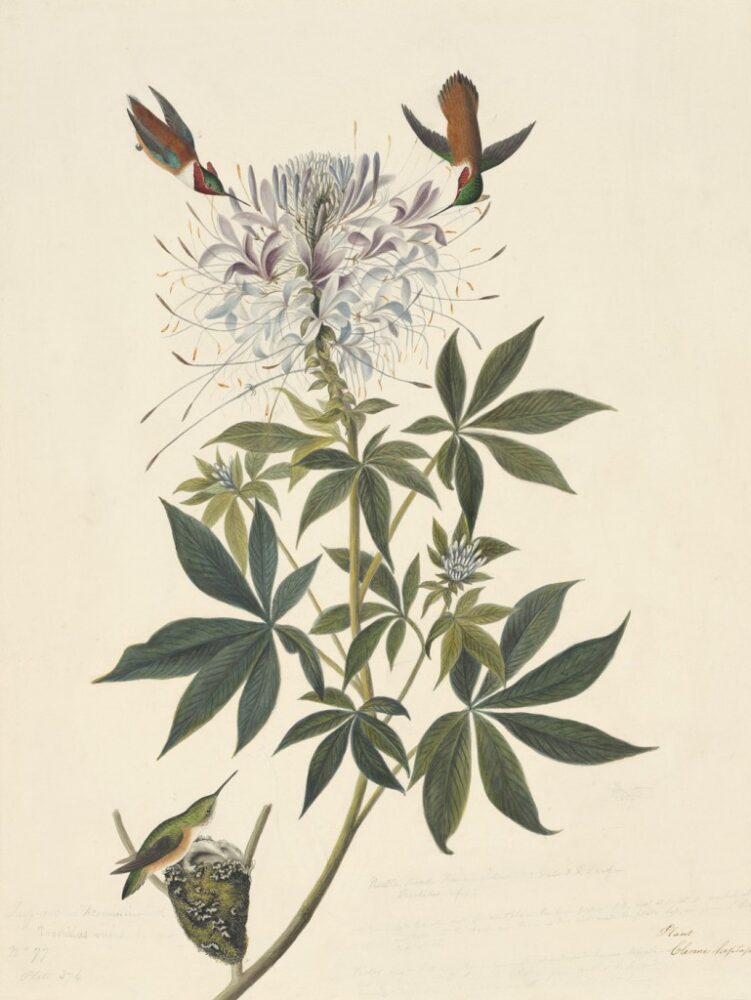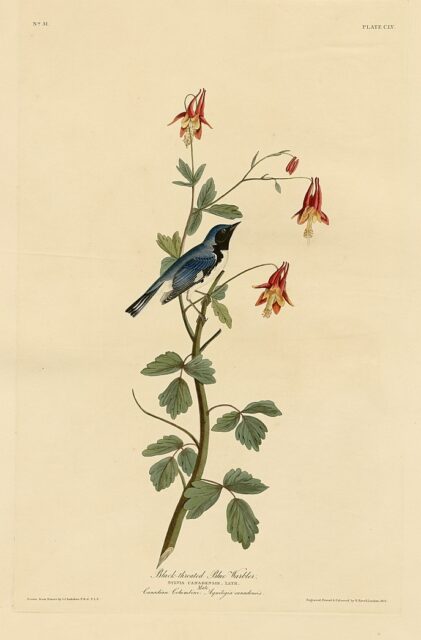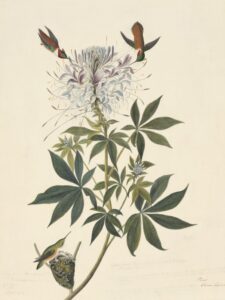On Birding in Louisiana
There’s plenty of competition in looking for birds
Published: August 31, 2021
Last Updated: March 22, 2023

University of Pittsburgh
Plate 359 of Birds of America by John James Audubon and Maria Martin, showing the rufous or ruff-necked hummingbird.
I respectfully disagree with Lynn’s oft-repeated declaration, and I am right according to Dictionary.com, which defines sport as:
- an athletic activity requiring skill or physical prowess and often of a competitive nature, as racing, baseball, tennis, golf, bowling, wrestling, boxing, hunting, fishing, etc.
- a particular form of this, especially in the out of doors.
One may not initially think of birding as athletic, but hiking through the woods, running from the occasional swarm of stinging insects, and craning your neck for prolonged periods in extreme yoga pose definitely requires some coordination and stamina.
Then there’s the competitive aspect—competition is everywhere you look when you bird. Sometimes it’s between the birds themselves; I once watched a red-bellied woodpecker and a red-headed woodpecker duke it out for who was going to breed in the nest hole in an oak tree in my backyard (the red-bellied was ultimately the victor). Other times the competition is with yourself. For example, trying to find a bird ensconced in leafy trees is a challenge, and even then, you might only get a quick or partial look, often at less than stellar parts of its body. Finally, birding is a sport because you can compete with other birders. There are outstanding places to bird called “hot spots” because of their propensity to attract birds. An electronic database called eBird keeps track of birders’ sightings and compiles ranked lists of birders who have seen the most species. For example, I am currently ranked fifteenth all-time in a hot spot called Peveto Woods, a Louisiana coastal chenier about seventeen miles east of the Texas state line—I can compete with other birders to try to break into the top-ten list of ranked birders at that location.
For twenty years, I have birded Louisiana’s coastline and coastal prairie, its extensive bottomland hardwood forests and piney woods, and have been able to take advantage of the immense biodiversity driven by the Mississippi River delta and the migratory flyways that make this state one of the top—though underrated—places in the country to bird.
During this time, I have experienced the thrill of victory—because I am seeking to see as many of Louisiana’s almost five hundred bird species as possible. (Currently I have 371 birds on my Louisiana state list. According to eBird, the top Louisiana birder of all time is Steve Cardiff, who has logged 430 species.) Whenever a bird I haven’t seen is reported, I drop everything (work permitting) to search for it. In January of this year, I went to Kincaid Reservoir in Alexandria because a birder named Jay Huner had spotted a red-necked grebe, defined as rare in Louisiana because it is seen four times or less in a ten-year period. Lynn and I drove 145 miles northwest of Baton Rouge and walked on a crescent-shaped, grass-topped levee around the massive reservoir looking for the bird. With hundreds of ruddy ducks and double-crested cormorants on the water, and a few eared and horned grebes mixed in, it was like searching for a needle in a haystack. Luckily for us, we located fellow birders Jay and Charlie Lyon, and after almost an hour of searching together, Charlie finally located the prize in his scope, several hundred yards offshore. Lynn and I experienced goosebump nirvana for this bird, its black cap, long neck, and almost silver-colored, downturned beak visible against the cloud-colored water.
There’s also the crush of defeat. On November 7, 2019, Gary Pontiff found a northern wheatear at the Beauregard Regional Airport in DeRidder. In response, birders flocked to this small community some forty miles north of Lake Charles to find the far off-course wheatear, who was conspicuously present in the grassy areas around the dumpster just south of the hangar. Lynn and I arrived to look for this bird in the early morning on Saturday, November 9, but the wheatear had already packed his bags and flown, with David Booth recording the last sighting at 2:15 p.m. on November 8. That was a 322-mile round trip for no bird. We’ve had similar unsuccessful trips for other species, including multiple trips for the same target bird, or trips for successive target sightings over time, such that black-throated blue warbler, red-necked phalarope, and mourning warbler top our “yet to be seen in Louisiana” list. Of these, the black-throated blue is our most mileage-intensive multi-miss, with about 1,325 miles of Louisiana highways and byways attributed to our decade-plus search.
Birding has allowed me to see the best of humanity, like the hummingbird–human connection I witnessed during the ice storm we experienced this past February. In a normal year, about 230 hummingbirds spend the winter in South Louisiana, a number we know because Dr. Erik Johnson, Director of Bird Conservation for Louisiana Audubon, compiles our collective sightings each year. Some of these birds are hardy ruby-throated hummingbirds that we see during the rest of the year, but most are western species that winter on the Gulf Coast courtesy of “the southwest express,” meaning that they head in this direction rather than to their typical wintering grounds in Central or South America.

The beauty of birds and the drive to capture it has fascinated observers since time immemorial. Plate 155 of Birds of America by John James Audubon, depicting the black-throated blue warbler. University of Pittsburgh
This past winter, more than eight hundred hummingbirds, mostly rufous hummingbirds, graced flowers and feeders in more than twenty parishes. The ice storm resulted in prolonged cold temperatures that froze the nectar in hummingbird feeders, while encasing flowers in a layer of ice too thick for the hummingbirds to break through. Birding experts throughout the state used well-established networks to suggest rotating our hummingbird feeders so that when the nectar froze in the feeder outside, we’d have a fresh, non-frozen version to hang in its place. The result was that most of these hummingbirds made it through that devastating storm, including the first wintering hummingbird we had ever hosted. We named our first year male rufous hummingbird Pikachu, for his tendency to stay hidden and to swipe quickly at our feeders. Lynn and I felt like proud pseudo-parents when, in mid-March, Pikachu had grown into male adult splendor. I was thrilled when I was able to get decent photographs shortly before Pikachu departed for points west.
Birding is precious to me because it is something that always puts me utterly in the moment. Everything else just falls away. For me, birding has been a healing force while I work through grief and an antidote to the tendrils of everyday stress. The male Blackburnian warbler I saw in my backyard this morning looks like it stuck its head into a fireball sunset. It’s tough to conjure anything but awe in response. In this regard, maybe Lynn is right that birding is not a sport at all—really, it’s more like a salvation.
Whether you seldom notice birds, enjoy them at your feeder occasionally, or make them a life-long pursuit, birds provide a window into the workings of the universe, and Louisiana provides a bountiful window to those who watch and listen.
Marybeth Lima is the author of Adventures of a Louisiana Birder: One Year, Two Wings, 300 Species, published by LSU Press in 2019. She is the Cliff & Nancy Spanier Alumni Professor and Chair of the Department of Biological & Agricultural Engineering at Louisiana State University in Baton Rouge.
Want to learn more about birds in Louisiana? The Audubon Society in Louisiana has an excellent website to help you get started: la.audubon.org/labirds. Local Audubon chapters can get you connected with birders in your area. The Louisiana Ornithological Society is also an outstanding organization to learn about birds; this group hosts field trips all over the state and hosts three meetings per year that involve speakers and guided birding trips. See losbird.org for details. If you want to sign up for winter hummingbird updates (or you have wintering hummingbirds of your own to report), contact Erik Johnson at [email protected].
